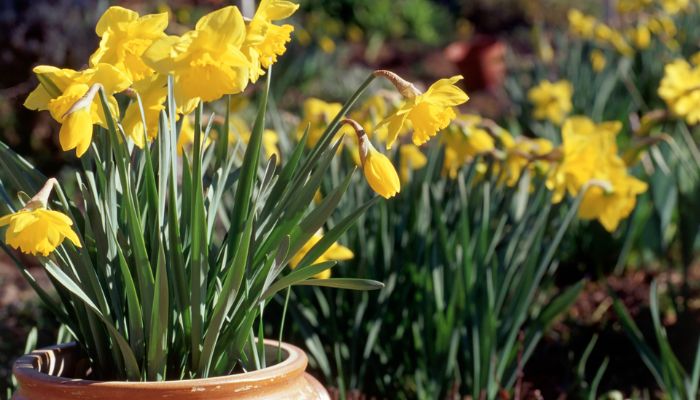Daffodils, with their radiant yellow blossoms, herald the arrival of spring. To create a captivating garden display, timing is everything when it comes to planting these vibrant flowers. This article provides information on “When to Plant Daffodils”, to ensure a thriving and colorful spring garden.
Understanding Daffodils
Before we delve into the planting schedule, let’s get acquainted with daffodils. Daffodils, scientifically known as Narcissus, are enduring perennial bulbs celebrated for their trumpet-shaped flowers that come in an array of hues, including yellow, white, and orange. These hardy, low-maintenance plants can flourish in diverse climates.
The Prime Time for Planting Daffodils
Here is the information on the perfect timing planting daffodils:-
Autumn Planting (Highly Recommended):
The ideal window for planting daffodils is during the autumn season. Typically, this period spans from late September to early November, contingent on your specific climate. Autumn planting allows daffodil bulbs to establish robust root systems before the harshness of winter, ensuring a spectacular spring bloom.
Winter Planting (Feasible in Mild Climates):
In regions with temperate winters, daffodils can be planted as late as December. However, this method carries some risk as the bulbs may not have ample time to root before the ground freezes.
Early Spring Planting (Not Advisable):
While it’s possible to plant daffodils in early spring before the ground fully thaws, it’s not recommended. Late planting can result in delayed or lackluster flowering, as the bulbs won’t have sufficient time to develop their essential root structures.
Preparing for Planting
- Selecting the Optimal Location: Daffodils thrive in well-draining soil and favor locations with partial to full sunlight.
- Soil Preparation: To enhance drainage and soil quality, ensure the soil is loose and enriched with organic matter. Daffodils dislike soggy soil conditions.
- Planting Depth: Dig a hole that is approximately three times the height of the bulb, ensuring that you plant it with the pointed end facing upwards. Typically, a planting depth of around 6 inches (15 cm) is recommended, but this can vary depending on the bulb’s size.
How to Care Daffodils?
- Proper Watering: After planting, provide your daffodils with a generous watering to settle the soil. Throughout the growing season, maintain regular watering, especially during dry spells.
- Thoughtful Fertilization: Apply a balanced fertilizer in early spring when the shoots begin to emerge, and repeat after flowering. This nourishes the bulbs for the subsequent year’s growth and blooms.
- Deadheading: Remove spent flowers promptly to redirect energy back into the bulbs and discourage self-seeding.
- Avoid Premature Leaf Trimming: Allow the leaves to naturally wither and die back after the flowering period. The leaves play a crucial role in storing energy within the bulb for the upcoming season.
FAQs
What’s the best time to plant daffodils?
The ideal time to plant daffodils is in the autumn, typically from late September to early November. This ensures that the bulbs establish strong roots before winter, leading to a vibrant spring bloom.
Can daffodils be planted in winter?
In regions with mild winters, you can plant daffodils until late December. However, there’s a risk involved, as the bulbs may not have sufficient time to root before the ground freezes.
Is it advisable to plant daffodils in early spring?
Planting daffodils in early spring just before the ground fully thaws is not recommended. Late planting can result in delayed or suboptimal flowering because the bulbs won’t have enough time to develop vital root systems.
What type of soil do daffodils prefer?
Daffodils thrive in well-drained soil and prefer locations with partial to full sunlight. Ensure the soil is loose and enriched with organic matter to enhance drainage.
How deep should daffodil bulbs be planted?
Dig a hole that’s roughly three times the height of the bulb and plant it with the pointed end facing upwards. Typically, a planting depth of around 6 inches (15 cm) is recommended, though it can vary based on the bulb’s size.
How often should daffodils be watered?
After planting, thoroughly water daffodils to settle the soil. During the growing season, maintain regular watering, especially in dry conditions. Keep the soil consistently moist but not waterlogged.
Do daffodils need fertilization?
Yes, daffodils benefit from fertilization. Apply a balanced fertilizer in early spring when the shoots emerge and again after flowering. This provides the bulbs with the necessary nutrients for the next year’s growth and blooms.
Is deadheading daffodils necessary?
Yes, it’s advisable to deadhead daffodils by promptly removing spent flowers. This practice redirects energy back into the bulbs and prevents self-seeding.
Can I trim daffodil leaves after flowering?
It’s essential to allow daffodil leaves to naturally wither and die back after the flowering period. The leaves play a crucial role in storing energy within the bulb for the next season’s growth and blooms.
Are daffodils easy to care for?
Yes, daffodils are relatively low-maintenance and hardy plants. With proper planting, watering, and fertilization, they can thrive in various climates and reward gardeners with beautiful spring blooms year after year.
Conclusion
Precise timing is pivotal when it comes to planting daffodils for a lively and radiant spring garden. For optimal results, aim for autumn planting to grant your bulbs ample time to establish robust roots before winter’s arrival.
With diligent care and attention to these guidelines, your daffodils will reward you year after year with their breathtaking blooms, heralding the arrival of spring with their sunny and vibrant presence. In this article, we have provided information on “When to Plant Daffodils”, to ensure a thriving and colorful spring garden. I hope you like it. Happy gardening!

